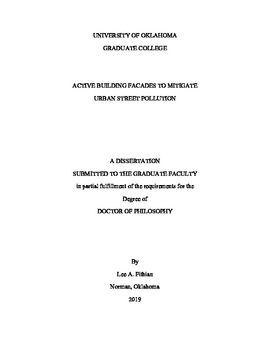| dc.description.abstract | This multidisciplinary research utilizes current thinking in planning, engineering, science and architecture, and proposes an interdisciplinary solution for addressing urban air pollution related to increasing urbanization. The premise that buildings are interconnected with urban infrastructure, with buildings serving as a resource and not just as a load, and the use of an active building facade to remediate environmental air pollutants beyond the building’s perimeter, represents a fundamental paradigm shift as to the nature of buildings in the urban environment.
Form Based Codes (FBCs) are urban design guidelines which also provide requirements for street dimensions between building facades and height limitations of buildings based upon the number of stories. If these FBCs do not control for height to width ratios, they can result in a morphology called an urban street canyon. The vertical dimension of a street canyon corresponds to the height of a building (H) which is typically regulated by the number of stories (floors). The horizontal dimension of a street canyon, the width of the street (W) and associated frontage, corresponds to the right of way (ROW) which is the space between building lot lines. The most important geometric detail about a street canyon is the ratio of the canyon height (H) to canyon width (W), H:W, which is defined as the aspect ratio because when the value of the aspect ratio is >= 1:1, air pollution can accumulate at the street level. The problem becomes one where FBCs are setting urban design guidelines for streets, ostensibly for walkability, but are unintentionally creating street canyons which are accumulating unhealthy air pollutants in the very locations where they hope to encourage people to walk.
Within the envelope of an urban building, air quality is an issue addressed almost completely as an internal requirement. Building ventilation systems rely on internal air quality monitoring and are designed to optimize energy efficiency for the building and its occupants. There are no studies that suggest that the building HVAC system should be used to ameliorate air pollution found outside the building, except for use within the building perimeter. This research investigated the capacity of a double-skin-facades (DSF), an active façade system typically used only for building HVAC, to evacuate air at the street level within the frontage zone of influence, as well as whether the DSF could actually remove criteria pollutants from the streetscape where human interaction is being promoted.
Aside from matters of cost, DSFs have had little impact in the United States because they do not effectively filter air pollutants, which is especially troubling if they are to be used for fresh air intake. Plant integration into a DSF has been proposed for thermal mitigation; however, the suggestion that the plants could also create a functional component to filter the air has not. The NEDLAW vegetated biofilter reduces concentrations of toluene, ethylbenzene, and o-xylene as well as other VOCs and PMs. A DSF integrated vegetated biofilter has numerous benefits for streetscapes and opportunities for expanded use of an energy efficient system that serves not only the building occupants but the urban environment.
This research developed and evaluated an active DSF building system for the evacuation and amelioration of street level air pollutants. Several modeling methods, including computational fluid dynamic (CFD) simulation and experimental validation through the use of a boundary layer wind tunnel were employed. The results based upon CFD modeling showed definitive removal of street level air pollution with mixing with upper boundary air. The numerical modeling process identified gaps in the CFD analyses particularly with regarding to multi-scalar meshing of the DSF within the street canyon. Experimental verification and validation of the active DSF using an urban boundary layer wind tunnel also showed definitive ventilation of street level air pollution and mixing with upper boundary air. Furthermore, the data showed that a vegetated biofilter would be able to operate within the operational parameters of the DSF.
This research identified a means to extend the building systems to function as urban infrastructure for purposes of air pollution removal. The development of a method where investment in a building system is an investment in the city’s infrastructure is a paradigm shift that has led to the identification of multiple avenues of future interdisciplinary research as well as informing future urban design guidelines. | en_US |
